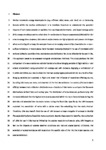To fly or not to fly? Comparing vantage point and uncrewed aerial vehicle surveys for assessments of seabird abundance and fine-scale distribution
| dc.contributor.author | Costagliola-Ray, MM | |
| dc.contributor.author | Lieber, L | |
| dc.contributor.author | Nimmo-Smith, Alex | |
| dc.contributor.author | Masden, EA | |
| dc.contributor.author | Caplat, P | |
| dc.contributor.author | Wilson, J | |
| dc.contributor.author | O'Hanlon, NJ | |
| dc.date.accessioned | 2022-10-02T22:07:28Z | |
| dc.date.available | 2022-10-02T22:07:28Z | |
| dc.date.issued | 2022-11 | |
| dc.identifier.issn | 1873-6432 | |
| dc.identifier.issn | 1873-6432 | |
| dc.identifier.other | 106906 | |
| dc.identifier.uri | http://hdl.handle.net/10026.1/19665 | |
| dc.description.abstract |
Marine renewable energy developments (e.g. offshore wind, wave, and tidal) are an increasing feature within the marine environment. It is therefore important to understand the potential impacts of such developments on seabirds that use these environments. Land-based vantage point (VP) surveys are widely used to collect data for environmental impact assessments (EIAs) within tidal stream energy sites. However, tidal stream environments are highly dynamic and present challenges when conducting VP surveys, for example there can be varying detectability of seabirds due to near-surface turbulence. In recent years, there has been increasing interest in the use of uncrewed aerial vehicles (UAVs) to quantify animal abundance and distribution. Yet, to be effective for its use in EIAs, this approach needs to be assessed alongside standardised methods. This study provides the first comparison of at-sea abundance and distribution of surface-foraging seabirds in flight within a tidal stream environment using concurrent VP surveys and UAV transects. Applying a combination of GLMMs and GAMs, our results show that the two survey types produced similar counts of surface-foraging seabirds (tern species) in flight and reveal the influence of covariates affecting counts, including tidal state, sea state, and observer ID. Further, we estimated the overlap (Bhattacharyya's affinity) between tern utilization distributions as a function of tidal state to compare the fine-scale distributions derived from each survey type. The distribution of terns detected, particularly by UAV transects indicated that the highest tern density occurred within the near-shore shallows during the ebb tide and extended into the main channel during the flood tide. Specifically, the UAV transects captured the association of terns with a visible shear line extending into the main channel. Therefore, EIAs may benefit from the use of UAV transect surveys alongside VP surveys to identify fine-scale distributions of seabirds more accurately. Despite these potential benefits, the application of UAVs for use in EIAs may be limited by the species resolution achievable using UAV imagery as well as the impacts of adverse weather conditions and low sun angles (glare). Ultimately, the selection of survey techniques will depend on the specific aims of the EIA, the target species, and species behaviour. | |
| dc.format.extent | 106906-106906 | |
| dc.language | en | |
| dc.language.iso | en | |
| dc.publisher | Elsevier | |
| dc.rights | Attribution-NonCommercial-NoDerivatives 4.0 International | |
| dc.rights.uri | http://creativecommons.org/licenses/by-nc-nd/4.0/ | |
| dc.subject | Ornithology | |
| dc.subject | EIA | |
| dc.subject | Marine renewable energy | |
| dc.subject | Land -based surveys | |
| dc.subject | Drone | |
| dc.subject | Survey method | |
| dc.title | To fly or not to fly? Comparing vantage point and uncrewed aerial vehicle surveys for assessments of seabird abundance and fine-scale distribution | |
| dc.type | journal-article | |
| dc.type | Journal Article | |
| plymouth.author-url | https://www.webofscience.com/api/gateway?GWVersion=2&SrcApp=PARTNER_APP&SrcAuth=LinksAMR&KeyUT=WOS:000862425200001&DestLinkType=FullRecord&DestApp=ALL_WOS&UsrCustomerID=11bb513d99f797142bcfeffcc58ea008 | |
| plymouth.volume | 97 | |
| plymouth.publication-status | Published | |
| plymouth.journal | Environmental Impact Assessment Review | |
| dc.identifier.doi | 10.1016/j.eiar.2022.106906 | |
| plymouth.organisational-group | /Plymouth | |
| plymouth.organisational-group | /Plymouth/Faculty of Science and Engineering | |
| plymouth.organisational-group | /Plymouth/Faculty of Science and Engineering/School of Biological and Marine Sciences | |
| plymouth.organisational-group | /Plymouth/PRIMaRE Publications | |
| plymouth.organisational-group | /Plymouth/REF 2021 Researchers by UoA | |
| plymouth.organisational-group | /Plymouth/REF 2021 Researchers by UoA/UoA07 Earth Systems and Environmental Sciences | |
| plymouth.organisational-group | /Plymouth/Research Groups | |
| plymouth.organisational-group | /Plymouth/Research Groups/Marine Institute | |
| plymouth.organisational-group | /Plymouth/Users by role | |
| plymouth.organisational-group | /Plymouth/Users by role/Academics | |
| dcterms.dateAccepted | 2022-08-30 | |
| dc.rights.embargodate | 2022-10-7 | |
| dc.identifier.eissn | 1873-6432 | |
| dc.rights.embargoperiod | Not known | |
| rioxxterms.versionofrecord | 10.1016/j.eiar.2022.106906 | |
| rioxxterms.licenseref.uri | http://creativecommons.org/licenses/by-nc-nd/4.0/ | |
| rioxxterms.type | Journal Article/Review |



